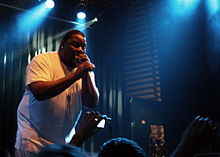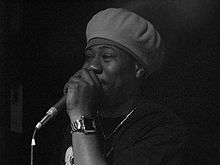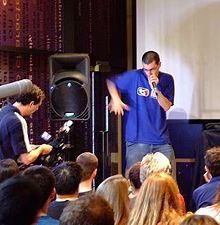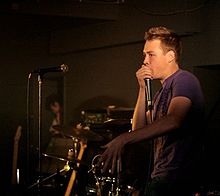- Beatboxing
-
"Beatbox" and "Beat box" redirect here. For other uses, see Beatbox (disambiguation).An example of modern beatboxing

Beatboxing is a form of vocal percussion primarily involving the art of producing drum beats, rhythm, and musical sounds using one's mouth, lips, tongue, and voice. It may also involve singing, vocal imitation of turntablism, and the simulation of horns, strings, and other musical instruments. Beatboxing today is connected with hip-hop culture, being one of "the elements", although it is not limited to hip-hop music.[1][2]
The term "beatboxing" is sometimes used to refer to vocal percussion in general (see vocal percussion for details).
Contents
History of beatboxing
Prehistory
Two earlier examples of vocal imitation of percussion sounds are bol, which originated in India several thousand years ago[when?], and the Chinese Kouji, a type of vocal performing art. These had little or no relation with hip hop, however, and have no direct connection to modern Eastern Hip Hop.
Other vocal imitative styles may have had some influence on the development of hip-hop, although this idea is difficult to prove. Significant examples include scat singing, associated with Jazz music, and puirt a beul, which originated in traditional Scottish music. Jazz, which developed from the blues and other African-American and European musical traditions and originated around the beginning of the 20th century, has also influenced hip hop and has been cited as a precursor of hip hop.[3]
Additional influences may perhaps include forms of African traditional music, in which performers utilize their bodies (e.g., by clapping or stomping) as percussion instruments and produce sounds with their mouths by breathing loudly in and out, a technique used in beatboxing today.
Origins in hip hop
The term "beatboxing" is derived from the mimicry of the first generation of drum machines, then known as beatboxes. "Human beatboxing" in hip-hop originated in 1980s. Its early pioneers include Doug E. Fresh, the self-proclaimed first "human beatbox",[4] Swifty, the first to implement the inhale sound technique[citation needed], Buffy, who helped perfect many beatboxing techniques[citation needed] and Wise, who contributed significantly to beat boxing' proliferation[citation needed]. Wise inspired an entire new fan base of human beatboxers with his human turntable technique. However, Brazilian singer, songwriter and musician Marcos Valle mimicked a drum kit with his voice at his 1973 track "Mentira", from the "Previsão do Tempo" LP, in a very similar manner to what came to be called "beatboxing" one decade later. Therefore one can consider him as a direct precursor of beatboxing in funk. Differently from what John Mayall did in 1969 (a free improvise emulating a percussion solo), Marcos Valle performed a pattern and his vocals sounded like a drum kit.
Modern beatboxing
Beatboxing's current popularity is due in part to artists such as Rahzel of the Roots, Kenny Muhammad, and Matisyahu who have promoted the art form across the globe.[5] Websites also contribute substantially toward raising beatboxing's profile including HumanBeatbox.com and Beatbox Battle TV. Michael Jackson was known to record himself beatboxing on a dictator tape machine as a demo and scratch recording to compose songs Billie Jean, Tabloid Junkie, Who Is It, and others.[6]
Sometimes, artists will use their hand or another part of their body to extend the spectrum of sound effects and rhythm. Some have developed a technique that involves using their hands to produce very realistic scratching effects, which they use in beatboxing. Another artist from Belgium cupped his hands to make bird and ocean sound effects in his beatboxing, and so forth. See: http://www.youtube.com/watch?v=qsDdoI6g290&feature=channel_video_title
In 1969, John Mayall recorded "Room to Move" live on his Turning Point album, which features a vocal percussion solo from 1:48 to 3:00. [7]
In 1998, Wes Carroll developed "Mouth Drumming," the first vocal percussion video instructional series (first on VHS, and later DVD). Many beatboxers credit this series with their entry into beatboxing.
In 2001, Gavin Tyte developed the first audio and text beatboxing tutorials on the Internet, then in 2002 he produced the first video tutorials on making beatboxing sounds and rhythms.
In 2002, Humanbeatbox.com went online and quickly became the hub of the online beatbox community.
In 2003, the first International Human Beatbox Convention (Boxcon) was held in London. Hosted by Alex Tew, Gavin Tyte, and Mark Splinter from humanbeatbox.com, beatboxers from all over the world gathered to jam, listen to talks, and share tips.
In 2004, Honolulu native Jason Tom began perpetuating the art of beatboxing throughout Hawaii after having caught Asian American vocal percussionist Elaine Chao entertain a crowd beatboxing on the Showtime At the Apollo television show. He then founded, Oahu's first beatboxing home base, the Human Beatbox Academy reaching out to Hawaii youth and communities.
In 2005, the World Beatboxing Championships was organised in Leipzig, Germany. Participants included Tom Thumb, Joel Turner (Australia), White Noise (Ireland), RoxorLoops (Belgium), Poizunus, (Canada), and Faith SFX (UK). After several rounds of beatbox battles and competitions, the finals between RoxorLoops (Belgium) and Joel Turner (Australia) was decided. The five judges had a difficult time picking a winner and called for two extra rounds, after which Joel Turner was declared World Beatbox Champion.
The first UK Beatbox Championships took place in 2005 with Faith SFX taking the national title.
Also in 2005, Beatbox Battle TV was founded September 2005 at the 1st Beatbox Battle World Championship event by Bee Low, B-Film, and Philibox. Today, it has become the largest beatboxing film archive in the world.[8]
In July 2009, The World Beatbox Association (WBA) was founded, and set about organizing the first American and Canadian Beatbox Championships.
Recently, a 2009 Beatboxing World Championship took place wherein over 52 beatboxers, including many females, competed for the title. The female British winner Bellatrix (UK), the male Swiss winner, ZeDe (SUI), and the band Under Kontrol (FR) are now the holders of the largest beatboxing title.
The first-ever American Beatbox Championships took place in 2010 as the centerpiece of the 2010 International Human Beatbox Convention in Brooklyn, New York. Many Americans are emerging on the world beatbox scene such as Matisyahu, Dachi Johnson, Billy Gillette, Blake Lewis, Blasterisk, Kidd Lucky, Frisco, and many others.
In 2011, Singapore's first ever monthly beatbox battle: 808beatz was scheduled to kick start on 10th of december. [9]
.
Notation
As with other musical disciplines, some form of musical notation or transcription may sometimes be useful in order to describe beatbox patterns or performances. Sometimes this takes the form of ad hoc phonetic approximations, but is occasionally more formal.
Standard Beatbox Notation (SBN) was created by Mark Splinter and Gavin Tyte [10] of Humanbeatbox.com in 2006[11] as an alternative to International Phonetic Alphabet (IPA) transcription, which had been used sparingly before then.
In 2010 the UK beatboxer Shlomo worked with composer Anna Meredith on a "concerto for beatboxer and orchestra", and developed a simple phonetic notation in order to create a score for the beatboxer.[12]
World records
According to the Guinness World Records™, the current record for the largest human beatbox ensemble [13] involved 1,246 participants and was achieved by Vineeth Vincent and Christ University (India) in Bangalore, Karnataka, India, on 5 February 2011.
This record was beaten by Google Employees on November 14th 2011 in Dublin with 2081 people participating. It was achieved by Shlomo and Testament.[citation needed]
Selected beatbox discography
This list is a selected discography of commercial releases which are mostly/entirely beatbox-based or are otherwise notable/influential records in the history of beatboxing and its popularisation.
1970s
- Marcos Valle, from Brazil, the father of the funky BeatBox - Mentira (1973)
1980s
- Michael Winslow - Police Academy (1984)
- The Fat Boys - Fat Boys (1984)
- Doug E. Fresh & Slick Rick - The Show, b/w La Di Da Di (1985)
- Just-Ice (featuring Davy DMX on beatbox) - Back to the Old School (1986)
- Wise - Just Say Stet (1985), Faye (1986) & Stet Troop 88 (1988)
- Biz Markie - Goin' Off (includes beatbox track "Make The Music With Your Mouth, Biz") (1988)
- Vanilla Ice - Havin' a Roni - from To The Extreme (1990)
1990s
- Rahzel - Make The Music 2000 (1999)
2000s
- Andre "D.R.E.S. tha BEATnik" Lett - Have Mic... Will Travel: The EP (2001)
- Kyle "Scratch" Jones - The Embodiment of Instrumentation (2002)
- Killa Kela - The Permanent Marker (2002)
- Rahzel - Rahzel's Greatest Knock Outs (2004)
- Marcelo D2 - Acústico MTV[citation needed] (2004)
- Björk - Medúlla (2004)
- Joel Turner - "These Kids" (2004)
- BEATBOX BATTLE® - "Beatbox Battle Express" (2005)
- Biz Markie - Make the Music with Your Mouth, Biz (2006)
- Poizunus - A.D.D. (Active Dreaming Disorder) (2007)
- Kid Beyond - Amplivate (2004)
- Blake Lewis - A.D.D. (Audio Day Dream) (2007)
- Logan Henderson - "Big Time Rush" (2009–present)
- Julia Dales - My angry song (2009)
See also
- List of beatboxers
- List of American beatboxers
- Hip hop music
- Konnakol
- Scat singing
- Puirt a beul
- Breath Control: The History of the Human Beat Box
- Michael Winslow
References
- ^ The History of Beatboxing, humanbeatbox.com
- ^ D. Stowell and M. D. Plumbley, Characteristics of the beatboxing vocal style. Technical Report C4DM-TR-08-01. 2008.
- ^ "The Roots of Rap". http://www.yazooRecords.com/2018.htm. Retrieved 2005-12-21.
- ^ Doug E. Fresh | Music Artist | Videos, News, Photos & Ringtones | MTV
- ^ Garfield, J. Breath Control: The History Of The Human Beat Box at the Internet Movie Database. 2002. A documentary on the history of the art form, including interviews with Doug E. Fresh, Emanon, Biz Markie, Marie Daulne of Zap Mama, Kyle Faustino, and others.
- ^ "Michael Jackson BeatBoxing" (Youtube video, 4:58 min). Jackson beatboxes while explaining how he composed Tabloid Junkie, The Girl is Mine, Who Is It, Billie Jean, & Streetwalker (song on the Bad Album 2001 Special Edition). 2008-03-27. http://www.youtube.com/watch?v=5C5he8XQCBw. Retrieved 2011-01-13.
- ^ http://www.youtube.com/watch?v=htt2Kcxuwfk
- ^ http://www.youtube.com/user/c4mc4st
- ^ http://808beatz.com
- ^ TyTe. "Standard Beatbox Notation". HumanBeatBox.com.
- ^ Liu, Marian (2007-01-04). "Beatboxing: An oral history; Hip-Hoppers Turn to Voice-Based Rhythms". San Jose Mercury News. (California).
- ^ Wyse, Pascal (2010-02-11). "Shlomo and the beatbox concerto". The Guardian. http://www.guardian.co.uk/music/2010/feb/11/shlomo-anna-meredith-beatbox.
- ^ "Largest human beatbox ensemble". http://www.guinnessworldrecords.com/Search/Details/Largest-human-beatbox-ensemble/57859.htm. Retrieved 2011-05-31.
External links
Categories:- Beatboxing
- Vocal skills
- Vocal percussion
Wikimedia Foundation. 2010.




